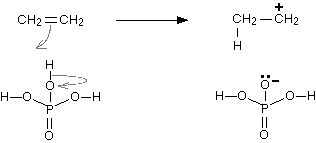
Write the mechanism of hydration of ethylene to ethyl alcohol.
Answer
561k+ views
Hint: To answer this question, you should recall the concept of hydration of alkenes to alcohols. This process involves electrophilic addition reaction for ethylene. For conversion to ethyl alcohol, Ethene is mixed with steam and passed over a catalyst consisting of solid silicon dioxide coated with phosphoric(V) acid. The temperature used is \[300{^\circ C}\] and the pressure is about 60 to 70 atmospheres.
Complete Step by step solution:
Alkenes refer to a group of unsaturated hydrocarbons that is one molecule of alkene containing at least one double bond. Due to the presence of pi electrons, they show additional reactions which involve an electrophile attacking the carbon-carbon double bond to form the addition products. These reactions are known as electrophilic addition reactions of alkenes.
The overall mechanism of this process can be summarized as:
Step 1: The hydrogen atoms of phosphoric(V) acid have a partial positive charge due to large disparity in electronegativities due to which these hydrogens are strongly attracted to the carbon-carbon double bond. The pi part of the bond breaks and the electrons in it move down to make a new bond with the hydrogen atom. The reaction can be represented as:

Step 2: This newly formed carbocation reacts with one of the lone pairs on a water molecule. The reaction can be represented as:

Step 3: Finally, one of the hydrogens on the oxygen is removed by reaction with the dihydrogen phosphate(V) ion, \[{H_2}P{O_4}^ - \], formed in the first step. The reaction can be represented as:

Note: You should know that alcohols are amphoteric. The lone pair of electrons on oxygen makes the \[{\text{-OH}}\] group a weak base. In this molecule, the oxygen can donate two electrons to an electron-deficient proton. This means that in the presence of a strong acid, \[{\text{R-OH}}\] acts as a base and protonated into the very acidic alkyloxonium ion. This weakly basic nature of alcohols is essential for its dehydration reaction with an acid to form alkenes. The temperature range for each substituted alcohol is different:\[1^\circ :{\text{ }}170^\circ {\text{ }} - {\text{ }}180{^\circ C},{\text{ }}2^\circ :100^\circ -{\text{ }}140{ ^\circ C},{\text{ }}3^\circ :{\text{ }}25^\circ -{\text{ }}80{^\circ C}\]
Complete Step by step solution:
Alkenes refer to a group of unsaturated hydrocarbons that is one molecule of alkene containing at least one double bond. Due to the presence of pi electrons, they show additional reactions which involve an electrophile attacking the carbon-carbon double bond to form the addition products. These reactions are known as electrophilic addition reactions of alkenes.
The overall mechanism of this process can be summarized as:
Step 1: The hydrogen atoms of phosphoric(V) acid have a partial positive charge due to large disparity in electronegativities due to which these hydrogens are strongly attracted to the carbon-carbon double bond. The pi part of the bond breaks and the electrons in it move down to make a new bond with the hydrogen atom. The reaction can be represented as:

Step 2: This newly formed carbocation reacts with one of the lone pairs on a water molecule. The reaction can be represented as:

Step 3: Finally, one of the hydrogens on the oxygen is removed by reaction with the dihydrogen phosphate(V) ion, \[{H_2}P{O_4}^ - \], formed in the first step. The reaction can be represented as:

Note: You should know that alcohols are amphoteric. The lone pair of electrons on oxygen makes the \[{\text{-OH}}\] group a weak base. In this molecule, the oxygen can donate two electrons to an electron-deficient proton. This means that in the presence of a strong acid, \[{\text{R-OH}}\] acts as a base and protonated into the very acidic alkyloxonium ion. This weakly basic nature of alcohols is essential for its dehydration reaction with an acid to form alkenes. The temperature range for each substituted alcohol is different:\[1^\circ :{\text{ }}170^\circ {\text{ }} - {\text{ }}180{^\circ C},{\text{ }}2^\circ :100^\circ -{\text{ }}140{ ^\circ C},{\text{ }}3^\circ :{\text{ }}25^\circ -{\text{ }}80{^\circ C}\]
Recently Updated Pages
Why are manures considered better than fertilizers class 11 biology CBSE

Find the coordinates of the midpoint of the line segment class 11 maths CBSE

Distinguish between static friction limiting friction class 11 physics CBSE

The Chairman of the constituent Assembly was A Jawaharlal class 11 social science CBSE

The first National Commission on Labour NCL submitted class 11 social science CBSE

Number of all subshell of n + l 7 is A 4 B 5 C 6 D class 11 chemistry CBSE

Trending doubts
10 examples of friction in our daily life

One Metric ton is equal to kg A 10000 B 1000 C 100 class 11 physics CBSE

Difference Between Prokaryotic Cells and Eukaryotic Cells

1 Quintal is equal to a 110 kg b 10 kg c 100kg d 1000 class 11 physics CBSE

State the laws of reflection of light

Explain zero factorial class 11 maths CBSE




